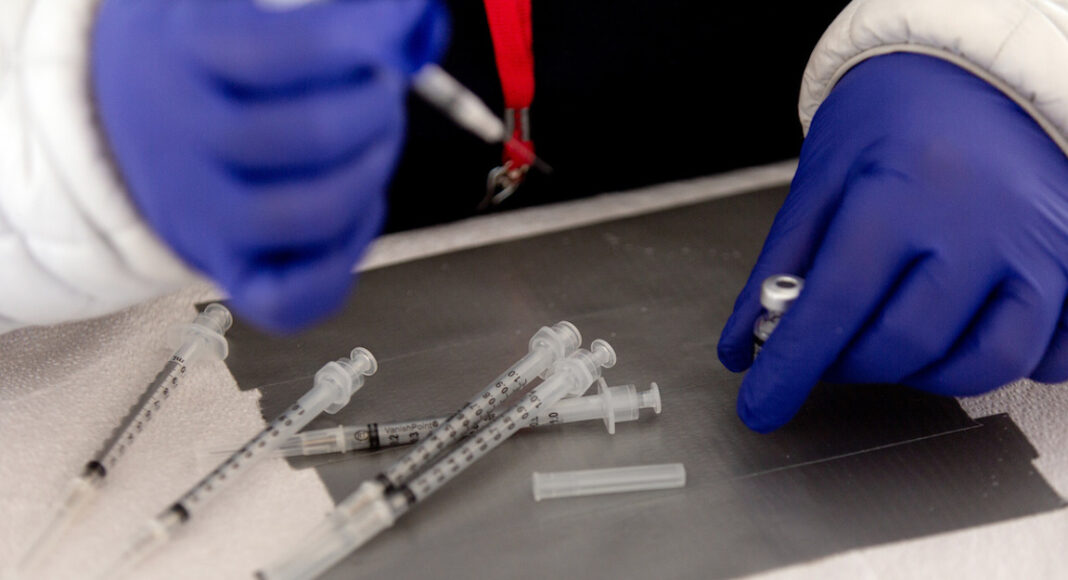By Apoorva Mandavilli, The New York Times
Struggling to decide which Americans need extra doses of the coronavirus vaccines made by Moderna and Johnson & Johnson, scientific advisers to the Centers for Disease Control and Prevention on Thursday homed in on the efficacy of the vaccines, and the relative advantages of mixing and matching different vaccine types.
In a meeting convened to review the data, the panel heard that in adults younger than 65, even those with chronic conditions, the Moderna vaccine remained highly protective against severe illness and showed only a small decline in effectiveness over time, if at all.
The Johnson & Johnson vaccine showed less efficacy than the Moderna vaccine overall, but the data were too limited to determine whether there might be a decline over time.
The Moderna vaccine was slightly less protective against infection in all age groups more than four months after immunization. But that may be because people may engage in riskier activities after they are vaccinated, rather than because the immunity from the vaccines is waning, experts said.
The purpose of the vaccines is to prevent illness severe enough to require medical attention and not to prevent infection, said Dr. Wilbur Chen, an infectious disease physician at the University of Maryland.
“It might be too much to ask for a vaccine, either a primary series or the booster, to prevent all forms of infections,” he said.
In the first major presentation in the meeting, representatives from Moderna presented evidence in support of a booster of 50 micrograms, half the dose given in the initial rounds.
The smaller dose is enough to rouse the immune system because “the memory immune system is starting from a different place than it was the primary series,” said Dr. Jacqueline Miller, a senior vice president at Moderna who presented the data.
The smaller dose may need to be delivered from the same vials now used for initial immunization, Miller conceded. Some panelists noted that this may increase the risk of contamination and incorrect dosing, and complicate data gathering. (Moderna has been testing vials that deliver smaller volumes to alleviate this problem, according to a former government official.)
The panel also heard data in support of a second Johnson & Johnson dose. Scientists from the company said they had estimated the rate of blood clots following vaccination — a particular concern in young women — at 15.1 cases per million following the first dose and 1.9 cases per million after the second.
“The government’s interpretation is that there’s no indication of an increased risk of these events after the second dose in any age group,” said Dr. Macaya Douoguih, head of clinical development and medical affairs at Janssen, who presented the data.
The panelists peppered the company’s scientists with questions about the validity of the data presented for Americans exposed to the delta variant, and for people who have weak immune systems.
Later, committee members are set to discuss the so-called mix-and-match strategy — whether people fully immunized with one company’s vaccine should be allowed to switch to a different one for their booster.
Scientists at the National Institutes of Health are testing combinations of boosters of the three vaccines. Preliminary data suggest that switching between two vaccine types produces a richer immune response than boosters of the same vaccine received initially.
Moderna boosters, after one of the other two vaccines, produces the strongest immunity, and boosting with Johnson & Johnson the least.
The panelists had discussed this strategy even at their meeting last month, and were full of praise for the study. The results are expected to influence their discussion on the mix-and-match approach Thursday.
CDC scientists said at the meeting that the vaccines are generally safe, with the exception of uncommon and mostly mild heart problems in young men. The risk of the condition — called myocarditis, an inflammation of the muscle — is highest after the second shot of an mRNA vaccine, and highest in males 18-24.
In males younger than 20, the condition may affect more than 100 males in every 1 million vaccinated. Studies have shown that the risk of heart problems after a bout of COVID-19 is much higher.
Some panelists said they worried about the risk of blood clots in young women who get a second dose of the Johnson & Johnson vaccine, and the risk of myocarditis in young men after a third dose of an mRNA vaccine. Perhaps young women should be directed to mRNA vaccines and young men to the Johnson & Johnson vaccine, said Dr. Helen Talbot, an infectious disease expert at Vanderbilt University in Nashville, Tennessee.
“We’re in a different place in the pandemic than we were earlier,” she said. The opportunities to mix and match vaccines “are priceless.”
On Wednesday, the Food and Drug Administration authorized boosters for millions of people who received the Moderna and Johnson & Johnson vaccines, just as it did for recipients of Pfizer-BioNTech shots last month. The FDA also gave the go-ahead for people eligible for boosters to get an extra dose of a different brand from the one they first received.
Despite the scientific intricacies of the discussion, the final recommendations from the panel are unlikely to bring surprises. The committee is expected to endorse additional doses of the vaccines for many Americans and to bring the country closer to fulfilling President Joe Biden’s promise to provide boosters to all adults.
It will not happen without some misgivings, however.
Some of the CDC’s advisers last month voiced strong reservations about a Pfizer-BioNTech booster, saying the science did not support additional shots for anyone other than older adults. A majority voted to recommend boosters for people with certain medical conditions that increase the risk of COVID-19.
The committee did not support boosters for people whose jobs expose them to the virus — but in a highly unusual move, Dr. Rochelle Walensky, the CDC’s director, overturned their decision.
This article originally appeared in The New York Times.














